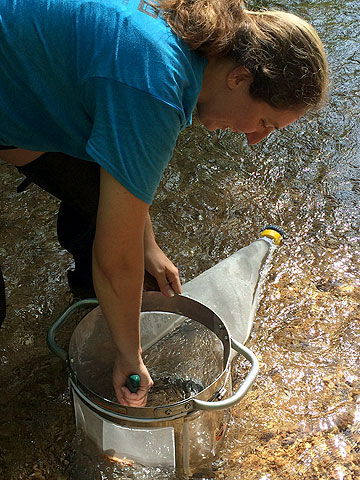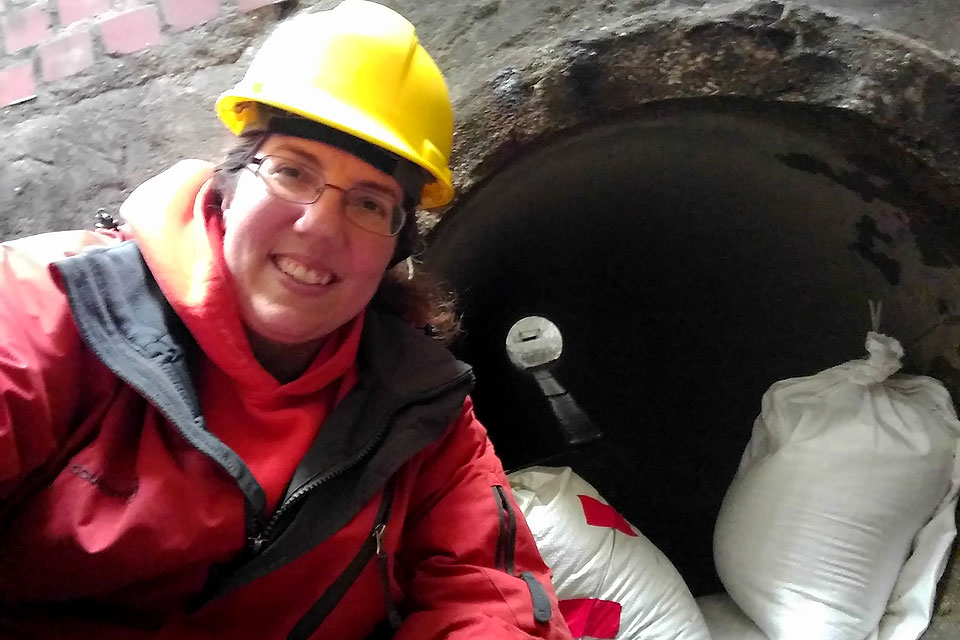Doctoral Student, 'River Hero' Wins National Scholar Award
As she pursues her doctorate in biology, Saint Louis University graduate student Danelle Haake spends hours crawling through storm water tunnels and exploring streams in an effort to discover how common chemicals used to treat roadways, like road salt, impact the St. Louis region’s streams and freshwater supplies.

She has also received national recognition for her work as a P.E.O. Scholar Award. The award highlights her research on the impacts of road salts on freshwater resources and biodiversity in the St. Louis region. The biology graduate student is one of 150 doctoral students from across the United States and Canada selected for the $15,000 award.
The P.E.O. Sisterhood is a philanthropic organization founded in 1869 where women support the advancement of other women through scholarships and grants. She presented on her findings in May and was sponsored by P.E.O.’s Centralia, Illinois, chapter.
The award will support Haake’s work identifying thousands of aquatic invertebrates she has collected over the past two years as well as publication and conference fees.
Haake began her SLU career as a high school student earning more than 20 credits in the 1818 program. After earning her bachelor's and master's degrees elsewhere, she returned to SLU to earn her doctorate. She's now entering her fifth year of graduate study.
Her work has previously been supported by a Bo Koster Scholarship from the Webster Groves Nature Society, a SLU Graduate Dissertation Fellowship and the Dr. Mary Louise Adams Dissertation Fellowship.
In 2017, Haake was honored with the year’s River Hero Award from the River Des Peres Watershed Coalition. She’s also been a member of Stream Team, a local group of water quality volunteers, coordinating efforts to sample winter chloride and to study stream pollution caused by road salt.
Learn About Haake's Award-Winning Work
Chloride pollution from road salt is a common issue in urban and suburban areas where salt is used to improve winter driving conditions. Chloride is corrosive to concrete and metal; it is also toxic to plants and freshwater aquatic life. Winter chloride in urban and suburban streams is often several times higher than U.S. Environmental Protection Agency (EPA) recommended limits for protection of fish and other animals that live in water.
- Identify the toxicity of chloride to stream insects and crustaceans under field-relevant laboratory conditions (e.g., appropriate winter temperatures),
- Determine the current levels of chloride exposure for aquatic organisms in St. Louis area streams by measuring in-stream chloride concentrations,
- Assess in-stream responses of aquatic invertebrates to existing chloride conditions in St. Louis area streams, and
- Examine the potential for decreasing chloride pollution by the adoption of brining (anti-icing) as a city public works best management practice.
So far, my work has led me into 20 small streams across St. Louis County (Ladue, Overland, Eureka, Ferguson, Creve Coeur, Brentwood, etc.) to measure chloride concentrations, collect data and identify the invertebrates living in each location.
Several of the streams have chloride concentrations that reach levels that are considered toxic to aquatic life. In fact, for a couple of hours, salt concentrations at one site reached concentrations higher than are found in seawater! These high concentrations were later linked to an uncovered salt pile in a parking lot about a half-mile away.
I've also worked extensively with the Missouri Stream Team, which led me to my doctoral work at SLU.
My initial interest in the field of Biology stemmed from my appreciation for nature. As an undergraduate, I participated in the Missouri Stream Team program which fostered my love for rivers and the ways that they connect habitats, species, and communities.
With my master’s degree, I was able to evaluate and reduce stream pollution as an Environmental Scientist with the Iowa Department of Natural Resources. I moved to St. Louis and became a Restoration Ecologist with the Missouri Botanical Garden (MBG). In this role, I restored habitats and educated students and volunteers about the connections between people and nature in their own neighborhoods.
In 2012, while I was working for MBG, I began coordinating 40 Stream Team-trained water quality volunteers to sample winter chloride and study stream pollution being caused by road salt. Unfortunately, use of Stream Team data by state management agencies was limited by the methods available to us. I saw a need to increase knowledge and awareness of the problems of road salt, both in the general public and in the scientific community. I jumped at the chance to meet this need by pursuing my PhD at SLU.
The Missouri Stream Team was my first real connection with water science as an undergraduate and this connection has developed into a great fascination and respect for the complexity and beauty of aquatic ecosystems.
I continue to be very involved in the Stream Team, largely through the non-profit Stream Teams United. I served for four years as the treasurer of this state-wide organization and another four years (recently completed) as president. During my time in these leadership roles, Stream Teams United has grown from a small group of individuals who would share their stories and knowledge with each other, into an organization that works to protect streams through education, stewardship, and advocacy.
As far as the Stream Team and my research, I couldn't ask for a more supportive group. Both the program staff in Jefferson City and the 40 local volunteers are thrilled with the partnership we've developed on this project. I have done several presentations for outreach: many for the general public that were well attended by Stream Team partners. I've also done a lot of outreach to the cities and consultants in the St. Louis area, including the American Public Works Association and the American Society of Civil Engineers.
I have spent many hours underground in stormwater pipes maintaining equipment, downloading data, and fielding questions from curious neighbors. While I never had any bad or frightening experiences in the stormwater system, it did take me a little time to get used to the echoing chatter of squirrels and periodic banging sounds as cars drove over the manhole covers.
As urban communities restore stream habitats, chloride pollution is one of the many parameters that must be considered. Chloride is a challenging pollutant in that it is difficult to remove once introduced to an aquatic system; there is no cost-effective filtration or removal mechanism. In regions where road salt is applied, the only way to reduce pollution is to decrease salt use.
The Jesuit mission is "To work for reconciliation every day — with God, with human beings and with the environment." This is a direct call for us to be stewards of the environment, a call to protect those who cannot protect themselves. This is a value I have worked to live each day.
I am active in a local Stream Team group - the River des Peres Watershed Coalition (RdPWC). The coalition recently hosted "Bike With Your Boots On," an event that serves as an opportunity for folks to enjoy a bike ride along one of the greenway trails, stopping a few times along the way to participate in water monitoring with Stream Team trained volunteers.
We'll also have the RdPWC's annual "Trash Bash," in October where volunteers go to stream sites throughout the St. Louis area to collect litter. Last year, SLU graduate students from the Graduate Student Association joined us.
We found that the use of brine (salt dissolved in water and sprayed on the roads a day or so ahead of the storm) results in an overall decrease in the amount of salt that reaches streams.
My stormwater study is the first to quantify stormwater chloride reductions as a result of brine use.
In addition, my work appears to be the first to combine continuous in-stream monitoring with invertebrate diversity and survival metrics to characterize the impacts of chloride on stream organisms.
I have submitted a manuscript which is under review about the stormwater best management practice work.
This summer I will be continuing to identify the thousands of aquatic invertebrates I have collected in the past two years. The support of the scholar award will be used to improve the reach of my research by allowing me to attend conferences and to pay open access fees for my upcoming publications. It will also provide the foundation for future work on the ability of species to adapt to high salt concentrations.
Check out Haake's progress and follow her research here.
Founded in 1818, Saint Louis University is one of the nation’s oldest and most prestigious Catholic institutions. Rooted in Jesuit values and its pioneering history as the first university west of the Mississippi River, SLU offers nearly 13,000 students a rigorous, transformative education of the whole person. At the core of the University’s diverse community of scholars is SLU’s service-focused mission, which challenges and prepares students to make the world a better, more just place.
Story and interview by Amelia Flood, University Marketing and Communications


















